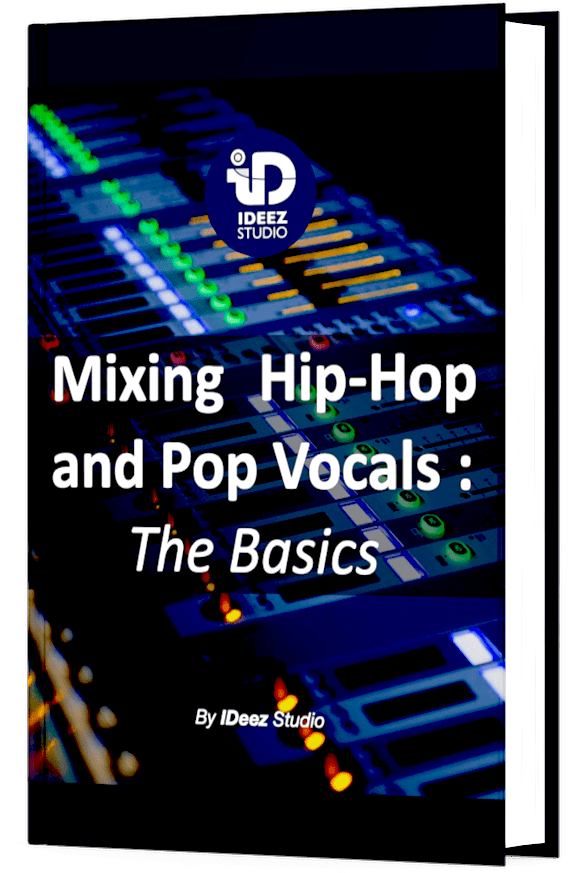When you work on something in your home studio, you probably have two choices: Listening through your monitor speakers or headphones. But which is best? And what are the pros and cons of each type of monitoring? In this article, I answer all these questions in depth, to help you determine what each type of monitoring can bring to your workflow.

First of all, it’s important to know that one is not inherently better than the other. Mixing your music with headphones could be ideal in one situation and horrible in another. The opposite is also possible. It all depends on the situation, the context and your preferences at any given moment when you’re working in your home studio.
Generally speaking, headphones offer detailed sound and privacy but lack spatial representation. Monitoring speakers provide natural sound with stereo imaging but are influenced by room acoustics. The choice will always be based on listening environment and preference.
The important thing to remember is that each type of monitoring has its pros and cons. Ideally, you should be able to analyze them point by point and continually adapt the type of monitoring accordingly.
Let’s take a look at what each type of monitoring can do for you, and what you need to pay attention to when choosing to listen through headphones or monitoring speakers.

Headphones Monitoring
✅ Pros of Headphones Monitoring ✅
Recording, producing or mixing music with headphones can have many advantages. Audio precision, isolation (in many cases), portability, rendering consistency… But it can also be problematic on certain levels, such as spatial representation, ear fatigue or dependence on very specific headphone models. Let’s take a closer look…

1. Detail and precision
The biggest advantage of headphone monitoring is the precision of the audio rendering. Indeed, when you listen to your music (or any other audio source) through headphones, every element will be perceived by the ear with the utmost precision.
Transients, for example, can be precisely analyzed. Dynamics are also very well rendered in studio headphones, as is the frequency spectrum. Headphones also give a very precise rendering of the balance between each element of your composition/mix.
In addition to the precise, accurate sound of studio headphones, the immersive aspect is also very important. It allows you to immerse yourself completely in what you’re working on, and “live” it more easily.
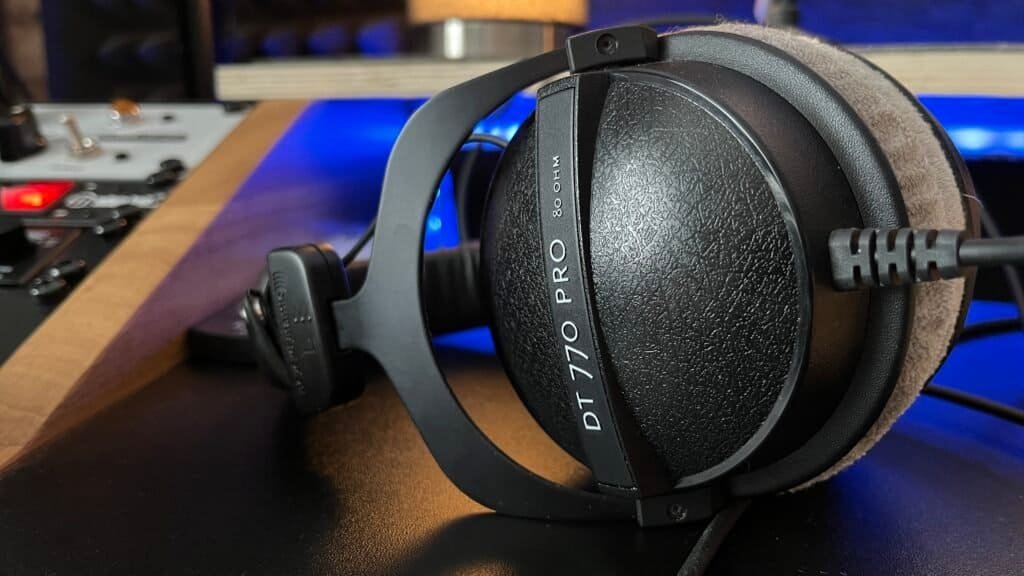
2. Isolation and privacy
Headphone monitoring also has the advantage over speakers of ensuring optimum isolation and therefore superior privacy.
Note: Open-back headphones, which are a specific type of studio headphones, don’t offer such isolation. So… be careful when you choose your headphones! If you want to learn more on the difference between open-back and closed-back headphones, you can click the link right here: Closed-Back vs Open-Back Headphones: What Is The Difference?
First and foremost, this type of monitoring allows you to “cut yourself off” from the world and immerse yourself in what you’re working on, without being disturbed by potential outside noise.
But it’s also potentially an advantage for those around you. Because the noise emitted outside the headphones will be extremely low, if not inaudible. If you live in an apartment, for example, this can be a huge advantage over speakers.

3. Portability and consistency
Headphones are a real luxury in terms of portability. It’s a bit like having a portable mini home studio, which you can take with you wherever you go. And that’s a hell of a lot more comfortable than speakers.
And the cool thing is, no matter where you go with your headphones, they’ll always sound exactly the same. The audio rendering will never change (unless you’re making music in your swimming pool…).
But some studio headphones are more portable than others. I’d advise you to find out more about this aspect if you ever plan to buy new headphones.
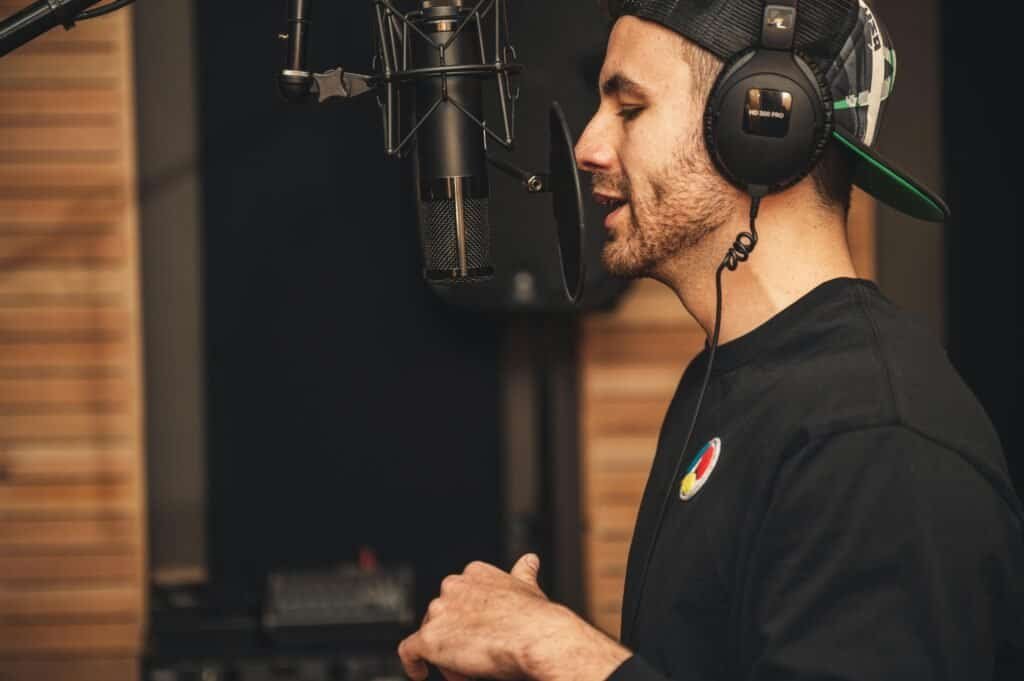
❌ Cons of Headphones Monitoring ❌
1. Spatial representation
Yes, headphones have the ability to render audio extremely accurately, but… this can become a problem for the perception of the overall image of the music you’re working on.
Indeed, studio headphones are known for over-separating the elements of a song. This can be a problem, given that the ultimate aim of mixing, producing and recording music is to end up with a product that sounds unified and harmonious.
Using headphones at the start of the music production process can therefore come in handy to get a good feel for each element that will make up the track. But it’s far from the ideal solution when it comes to building a polished, finished mix at the end of the process.

2. Ear Fatigue
We must never forget that listening to music through headphones represents a direct transmission of sound to the eardrums. And that this type of listening generates ear fatigue much more quickly and aggressively than a more “natural” and “distant” type of listening.
And this ear fatigue can manifest itself in two forms: short- and long-term.
Short-term ear fatigue can be felt in just a few hours, and completely skew listening objectivity. But a few minutes’ break is often enough to regenerate the objectivity of both ears and brain.
Long-term ear fatigue, on the other hand, is more difficult to detect, as it acts gradually over months. But it is impossible to cure.
That’s why you need to limit the amount of time you spend listening to headphones, as well as the volume. Excessive headphone volume is one of the main causes of premature ageing of the ear.

Monitoring speakers
✅ Pros of Monitoring speakers ✅
1. Natural sound reproduction
Monitoring speakers represent a much more natural type of monitoring than headphones. They are capable of reproducing a more “general” and harmonious image, making for more comfortable and pleasant listening over several hours.
Monitoring speakers are also capable of giving a sense of depth and 3rd dimension, which makes balancing and choosing effects (reverb, delay, etc.) much easier.
Being able to hear a global rendering of the sound can often make the task easier when it comes to mixing, production or mastering. This gives monitoring speakers a big advantage.
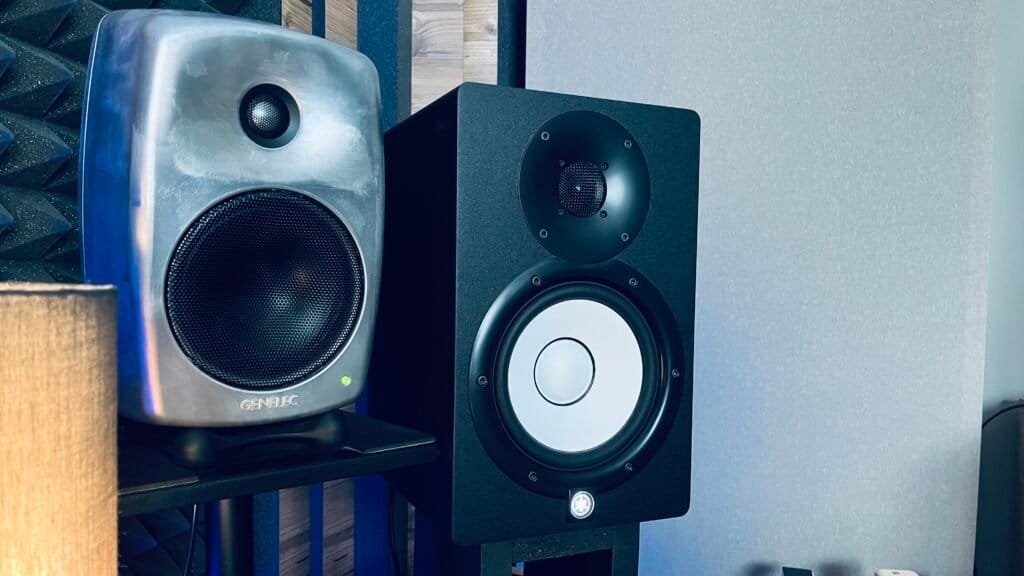
2. Shared experience
If you often produce-mix your music with other people in the same room, monitoring speakers will probably make your life easier, even if the acoustics can change the rendering depending on the position (we’ll come to that shortly).
This type of monitoring will enable you to share the same listening experience as the person(s) you’re with in your home studio. So you’ll hear the same qualities or faults in a track, making production sessions more productive.
As monitoring speakers are not placed directly in the ears like headphones, this type of listening will also greatly facilitate communication between you and your collaborators on site.

3. Room acoustic interaction
Of course, this is only true if the acoustics in your room are right. But it doesn’t take much for a room (even one with very light acoustics) to make the sound coming out of the speakers come alive in an impressive way.
What you should always bear in mind when listening to music through monitoring speakers is that what you’re hearing isn’t just the direct signal coming out of the speakers. There’s also an important part that comes from the reflections of the room you’re working in.
Walls, ceiling, floor, desk… All these reflective elements will influence the sound you hear, creating the lively whole which makes the charm of listening to speakers.
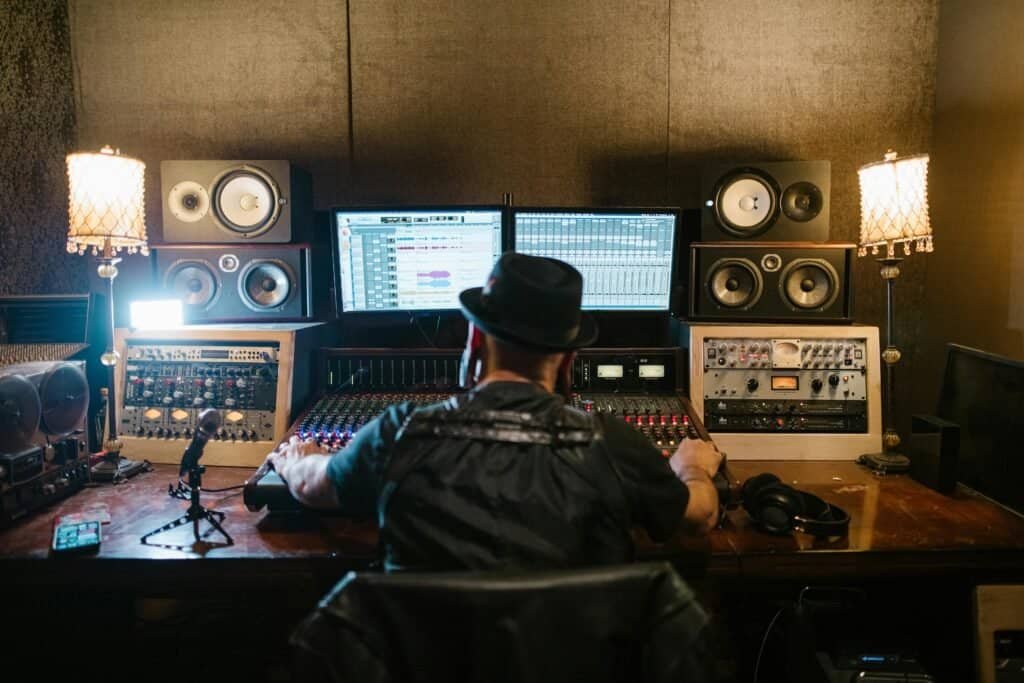
❌ Cons of Monitoring speakers ❌
1. Less reliability
But monitoring speakers also have their share of negative aspects, starting with their lesser reliability compared to headphones. Indeed, while room acoustics and distance from the ears give a “lively” effect to the sound, these aspects are also a source of unreliability.
The acoustics of your room, for example, may boost or cut certain frequency zones when the sound reaches your ears. Or you could also be trapped by your position when working on your music (sometimes all it takes is a few centimetres).
But this doesn’t mean that monitoring speakers are NOT reliable. Many professional monitors are incredibly accurate. It’s just not as accurate as monitoring with headphones.
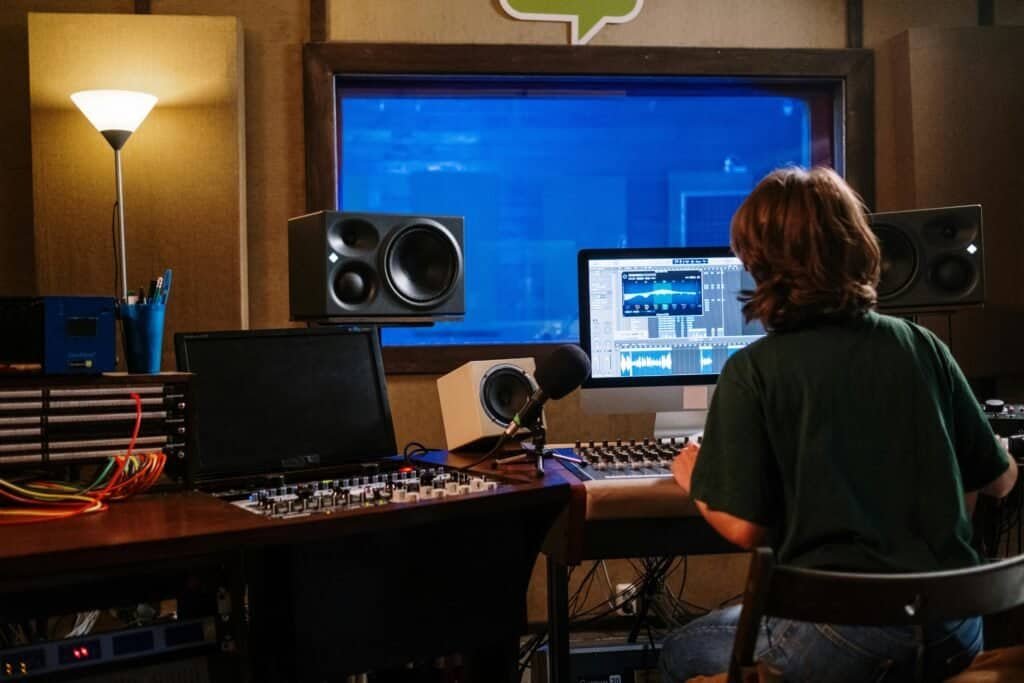
2. Space and setup requirements
You need a minimum of space to enjoy listening to music though monitoring speakers. Indeed, this type of monitoring require dedicated space and proper setup to achieve optimal performance. This may involve investing in speaker stands, acoustic treatment, and room calibration tools, as well as considering the layout and dimensions of the listening environment.
This also makes it very difficult to transport. Moving monitoring speakers to another location for a recording (or other) session means also taking the stands and cables with you, and taking into account their position to enjoy similar listening quality. As you can see, monitoring speakers don’t just move around!

Conclusion
In conclusion, headphones excel in providing detailed and precise sound reproduction with excellent noise isolation and portability. But they may fall short in representing spatial cues and imaging and can lead to listener fatigue over extended periods of use.
While monitoring speakers excel in providing a natural listening experience with realistic spatial representation but they may pose challenges related to room acoustics, noise isolation, and setup requirements.
The most important thing is not to stay on the same type of monitoring all the time. It’s essential to choose either headphones or speakers according to what’s ideal for the specific task you have to achieve.
If you have any questions about this topic or about anything in the field of music production, please make sure to contact me, I’ll be very happy to help you!
Related Articles:
My favorite tools for mixing pop and hip-hop music:
Plugins
In the field of auto-tune, I’m convinced that nothing’s better and more efficient than Antares Auto-Tune Pro. As for the EQ’s, FabFilter Pro-Q3 and Slate Digital Infinity EQ are, in my opinion, the best tools. For compression, I have 2 favorites plugins: Waves RComp and UAD EL8 Distressor.
As for reverb, I’m a big fan of the Soundtoys Little Plate, but generally, I go for the Valhalla VintageVerb for its versatility. I also love the Arturia Rev PLATE-140 and the UAD Pure Plate for its organic side.
Headphones
The closed headphones I love and will always love using for mixing pop and hip-hop music are the Beyerdynamic DT-770. As for the best open-back headphones, I use the Sennheiser HD600 headphones, and I’m really happy of them!
Monitors
Having a pair of Yamaha HS7 in its studio or home studio is always cool for more excitement while listening to your mixes. The Adam Audio T7V monitors are also super accurate. In my studio, I also have a pair of Genelec 8030 for their reliability.
Hardware gear
For anyone who wants to start using hardware in their mixes, I always recommend these 2 units from Klark Teknik: the EQP-KT and the 76-KT. Don’t forget to use good converters, such as the Apollo interfaces. This is essential for a good rendering.



